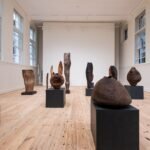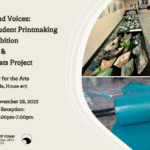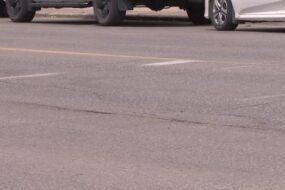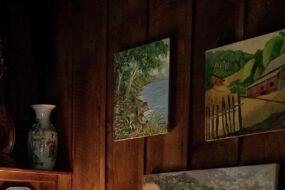
A previously unknown work has been analyzed and revealed using scientific research underneath an oil painting by the Italian Renaissance painter Tiziano Vecellio, better known as Titian.
The painting was found hidden underneath Titian’s Ecce Homo, an image of a bound Jesus wearing a crown of thorns standing next to Roman official Pontius Pilate, by researchers with the Andreas Pittas Art Characterization Laboratories at the Cyprus Institute following a preliminary x-ray and the observations of art historian Paul Joannides on the presence of a hidden work.
In the hidden portrait, Titian painted a mustachioed man holding a quill and standing next to a stack of papers. His identity is not known, and so the team has been ascribing to it the placeholder name Portrait of an Unknown Man.

A technical examination of Titian’s Ecce Homo is pictured in progress. Photo courtesy of Andreas Pittas Art Characterization Laboratories/STARC, The Cyprus Institute
The revelation was made in an APAC news release promoting an exhibition of the painting and the technology that led to its discovery at the Limassol Municipal Arts Center. APAC director Nikolas Bakirtzis told me over emails that the research team was originally asked to document the painting’s materiality and state of preservation.
Bakirtzis said that the work was being prepared for conservation when it was put underneath a microscope for examination. Researchers were surprised to see different colored pigments poking through the cracks of the aging painting’s surface.

Closeup detail of the surface of the Ecce Homo painting by Titian. Photo courtesy of the Andreas Pittas Art Characterization Laboratories/STARC, The Cyprus Institute
“Microscopic observations of the craqueleure of the painting allowed us to document the stratigraphy of the canvas and to detect, through the cracks, the existence of different pigments under the Ecce Homo composition,” he said. The term “stratigraphy,” typically associated with geology, in this instance means the different layers of paint and materials that make up the artwork, revealing how it was built up over time.
Bakirtzis described the process “like uncovering a puzzle” as the team was eventually able to reveal the material presence of a complete portrait. He said that when Titian painted Ecce Homo over it, he flipped the canvas, so it is upside down to the orientation of the newer artwork.
“The close documentation and analysis of the materiality of painting layers led to a better understanding of the artistic strategies employed by the Renaissance master and his studio when reusing canvases,” Bakirtzis said.

Enhanced visualization of an underlying portrait by Titian that he painted over to become Ecce Homo using scientific data. Photo courtesy of the Andreas Pittas Art Characterization Laboratories/STARC, The Cyprus Institute
Researchers aimed to examine how the composition of the portrait influenced this particular iteration of Ecce Homo, a theme that Titian explored on multiple occasions. The most renowned version of Ecce Homo by Titian, dating from 1543, is housed at the Kunsthistorisches Museum in Vienna. The compositions of each Ecce Homo vary.
“We found that parts of the facial characteristics, the contours of the man’s face, for example part of his jawline, follow the painting execution of the ropes tying Christ’s hands,” Bakirtzis said. “There are some other details in the background space and room represented in the portrait which also facilitate the drawing of the Ecce Homo composition.”

Director of the Andreas Pittas Art Characterization Laboratories (APAC) of the Cyprus Institute Nikolas Bakirtzis and artist Erato Hadjisavva, Dean and Professor of Painting in the Athens School of Fine Art, with the re-creation of the hidden painting underneath Titian’s Ecce Homo. Photo courtesy of Andreas Pittas Art Characterization Laboratories/ STARC, The Cyprus Institute.
The researchers worked with Erato Hadjisavva, a Cypriot artist and the dean of the Athens School of Fine Arts in Greece, on recreating the hidden portrait. She also provided professional interpretation of the study’s findings, including insight on why Titian may have flipped the canvas to reuse it.
“In our discussions, Hadjisavva said that this makes a lot of sense in art,” Bakirtzis said. “Turning the canvas upside-down helped to visually weaken or neutralize the portrait composition, thus facilitating the execution of the overpainting.”

A digital microscopy investigation of Titian’s Ecce Homo is pictured. Photo courtesy of Andreas Pittas Art Characterization Laboratories/STARC, The Cyprus Institute
Bakirtzis added that Titian effectively painted the new composition directly onto the portrait, which he said, “points to an experienced, confident artistic hand.”
The tone of the two paintings is markedly different. One is a portrait of an unknown professional man, and the other is a narrative scene from a known episode from the passions of Christ.
“They were intended for different clients and audiences. Unfortunately, this is as far as we can go until further research allows us to either identify the depicted man or we find ways to date the paintings,” Bakirtzis said. “We cannot really estimate how much earlier the first painting is. Any suggestion remains hypothetical and based on stylistic observations.”











